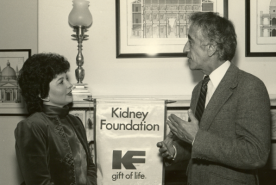Last Updated: September 17, 2024
Medically reviewed by NKF Patient Education Team
About medication costs
Medications can provide many health benefits, especially if you are living with kidney disease. For example, they can be used to:
- slow the progression of chronic kidney disease (CKD),
- treat other health conditions that affect your kidneys, like high blood pressure, diabetes, or kidney cancer,
- balance important vitamins and minerals,
- prevent your body from rejecting a kidney transplant, and
- help manage symptoms that can come with living with kidney disease.
Even though taking your medications as prescribed is very important, sometimes they can cost a lot. The high cost of medications can affect many other parts of your life – increasing your stress levels, affecting your sleep quality, and/or making it harder to pay for other basic needs like food or housing.
Medicines are safest and most effective when taken regularly and as prescribed by your healthcare professional. Do not lower your doses or stretch out doses to try and save money. This can be extremely dangerous and can make things worse.
If you are having trouble paying for your medications, this page has some options that may be available to help you.
Medication-related words and definitions
Before reading about ways to lower medication costs, it is important to know some of the words that are involved. The words related to medication costs can be unfamiliar and confusing. So, listed below are some of the most common words and what they mean.
Brand-name medication
This is a medication that is sold by the company that invented it. These are usually newer medications and have a high cost. They have a name created by the company that’s easier for people to recognize than the active ingredient (chemical or biologic name). For example, “Tylenol” is a brand name for the active ingredient “acetaminophen”. It costs a lot of money to research a new medication to make sure it is safe and effective. So, when a company invents a new medication, they are allowed to sell it without any competition for several years to help cover the costs spent on research.
Generic or biosimilar medication
This is a medication that has the same active ingredient as a brand-name medication but is sold under its chemical or biologic name. As in the example above, “acetaminophen” is the generic name for “Tylenol”. After a medicine has been available for a set number of years, other companies are then allowed to make and sell it too. With more companies competing to sell the medication, this usually lowers the cost. Generic and biosimilar medications work the same way as the brand-name version but usually cost much less.
Insurance premium
This is the amount of money you pay regularly (usually every month) to have health insurance. It may be helpful to think of it like a membership fee.
Insurance deductible
This is the amount of money you must pay out of your own pocket before your insurance starts to help pay for medications (or other health services). After you have paid this amount, your insurance starts to cover part of your medication costs. The deductible resets every year. So, medications may cost more in January than they do later in the year. Some insurance plans do not have a deductible.
Copay (also called Coinsurance or Cost sharing)
This is a set amount of money you pay each time you pick up a medication. Depending on the medication and your insurance plan, it can be either a set price (for example: 5 or 10 dollars) or a percentage of the medication price (for example: 10% or 25%). The rest of the cost is paid by your insurance.
Formulary
This is a list of medications that your insurance plan has agreed to cover (help pay for). When using insurance to pay for medications, the best way to lower your costs is to look for medicines on this list. Each insurance plan has a different list, and these lists may change every year. Also, your plan’s formulary may contain different levels (also known as tiers). So, just because a medicine is listed on your formulary, it does not always mean it is affordable.
Many programs exist to help lower the cost of your medication. However, not every program is available to everyone. Read more to learn more about some of the most common programs.
Low-cost generic programs
This type of program offers medications for a set low price. Some programs may also charge you a separate membership fee to participate (either monthly or annually). It works separately from insurance and is available to everybody (even if you have insurance or receive government assistance). Because it works outside of insurance, your payments do not count towards your deductible.
Low-cost generic programs usually have a list of available medications with each price clearly listed. The price will either be a fixed dollar amount (like $4 for a 30-day supply) or determined by the cost of the medication plus a dispensing fee. Sometimes, this price can be lower than your insurance copay amount. There are no special cards or coupons needed to get these prices (unless there is a membership requirement).
Almost all the medications available in these programs are generic. If a medication is only available as a brand-name product, it is usually not available through this type of program.
These programs are mostly offered by large retailers (also known as “big box” stores), grocery stores, and online merchandisers. Your local independent pharmacy may also offer a similar program.
Discount cards
This type of program also offers medications for a set price and works separately from insurance. So, it is available to everybody (even if you have insurance or receive government assistance). Because it works outside of insurance, your payments do not count towards your deductible.
Discount card programs are like a low-cost generic program but have extra steps to complete. The first step is usually searching a directory to see if your medication is available. Then, your zip code or address is used to search the prices in your specific area. If you have insurance, remember to compare these prices to your insurance copay. Once you’ve found the best option for you, print or download the card and bring it to that pharmacy with your prescription.
Almost all the medications available in these discount card programs are generic. If a medication is only available as a brand-name product, it usually is not available through a discount card program, or the negotiated price may still be too high.
Not all pharmacies accept these cards. So, when you use a discount card, pay extra attention to the directions about which pharmacy will accept it and how to use it.
Copay cards
This type of program works to lower your insurance copay. So, it only works if you have insurance. Also important, your insurance cannot be from a government program. This means people who have Medicare, Medicaid, and/or TRICARE cannot use these cards. Some states also have added restrictions on when and how copay cards can be used.
Copay card programs lower your copay, sometimes to as low as $0. This is because the company that makes the medication pays for part (or all) of your copay. Before using a copay card, it is important to read all the details that come with it. There is often a maximum discount that can be applied to your copay. So, the medication may still not be affordable to you if your copay is much higher than that amount. These cards also have expiration dates and/or a maximum number of times they can be used. So, your cost may go up once it runs out.
Almost all the medications available in these programs are brand-name. These cards are usually accepted at any pharmacy.
Patient assistance programs (PAPs)
This type of program offers medications for very little or no cost to you. They are designed for people who do not have insurance, or if your insurance plan does not cover the medication.
Other criteria that must be met include having permanent, legal resident status in the United States and making less than a certain income amount each year. The income limits vary depending on the program you’re applying for, how many people live in your home, and where you live. Criteria across programs are not standardized.
These programs require forms to be completed by you and your healthcare professional. These forms need to be submitted with supporting documents (like tax documents and proof of residence). You will need to reapply each year to prove you still qualify for the program.
If you qualify, your medication will be sent directly by the company that makes it – either directly to your home or to your doctor’s office (depending on how the program is set up).
Almost all the medications available in these programs are brand-name.
Other strategies to lower your costs
In addition to the programs described above, here are some more tips for how you might be able to lower your medication costs.
- Cash price: Next time you are at the pharmacy, ask “What would the price be if I didn’t use my insurance?” Prescriptions are often automatically processed through your insurance because the copay is assumed to be the least expensive option. However, this is not always the case, especially for generic medications. If the price without insurance is less, you can choose not to use your insurance for that medication.
- Check your insurance formulary: sometimes the medication prescribed for you is not covered by your insurance, but a similar one may be covered instead. Switching to the covered medicine often helps lower the cost significantly. Sometimes the formulary can be hard to understand so you can also try calling your insurance plan directly.
- Recheck your insurance plan regularly: If you have a Medicare Part D plan or purchase your insurance through the Health Insurance Marketplace, re-evaluate your insurance plan every year. Many people sign up for one plan and don’t ever think about changing it. As your health status and medications change over time, your insurance needs likely also change. A plan that worked for you ten years ago may not work now. So, make sure to re-check your insurance options every so often to make sure you find a plan that continues to meet your needs. The time to do this for Medicare Part D and the Health Insurance Marketplace is during the open enrollment period (usually between mid-October and mid-December).
Questions for your healthcare team
- Can you please refer me to a social worker to help me find ways to lower my medication costs?
- Are there any lower-cost generic alternatives to the medications I’m currently taking?
- Can we consider switching to a different medication that costs less but is still effective?
- Are there any special programs in our area that can help with lowering my medication costs?
- Can we work together to create a plan that prioritizes the most critical medications if I can't afford them all?
- Am I eligible for any prescription assistance programs (PAPs)?
- Am I eligible for veteran’s prescription coverage?
- Does my prescription plan cover nutrition supplements?
More Resources
- Insurance Options
- NKF-BuzzRx Prescription Discount Card
- Prescription Discount and Assistance Resources
- Expanded Medicare Coverage of Immunosuppressive Drugs for Kidney Transplant Recipients
- United States Health Insurance Marketplace
- About Medicare Part D (prescription drug coverage)
- Medicine Assistance Tool (MAT)
- RxAssist Patient Assistance Program Center
- NeedyMeds








